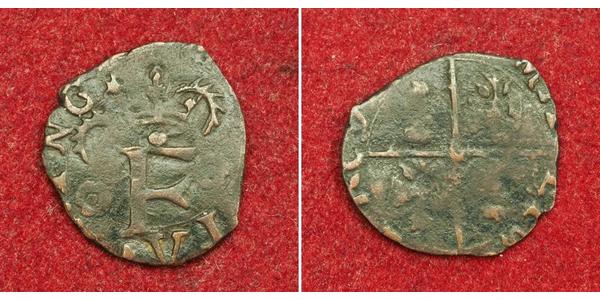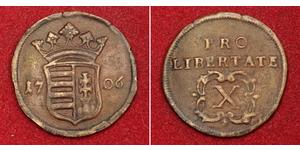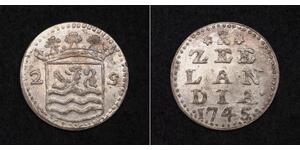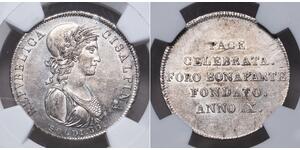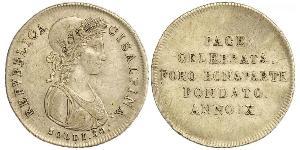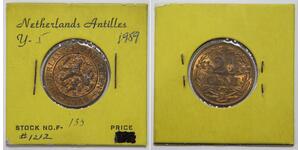(sold for $10.0)
1598, Milan (Duchy), Phlip II of Spain. Tiny Copper Trillina Coin. F+
Denomination: Trillina Mint Period: 1540-1598 Mint Place: Milano (Italy) Reference: Crippa 51 var. Condition: Crudely struck, otherwise F+ Ruler: Philip II (Felipe II) of Spain. (as Duke of Milano) Material: Copper Diameter: 14mm Weight: 0.57gm
Obverse: Crowned initial F, flanked by two rosettes.
Reverse: Arms of Milan in quartered fields.
The Duchy of Milan was a state in northern Italy from 1394 to 1797. It was part of the Holy Roman Empire, by then a decentralisedentity, and was ruled by several dynasties, most of them major powers from outside Italy. Although the Duchy's territory varied over the centuries, it generally covered much of Lombardy, including both Milan and Pavia, the traditional centers of the old Kingdom of Italy. Parma was also a part of the Duchy until it was split off into its own Duchy in the 16th century.
The Duchy was created in 1395 for Gian Galeazzo Visconti, Lord of Milan. When the Visconti became extinct in 1447, Milan declared itself a republic, despite the fact that the Duke of Orleans was the legitimate heir by treaty. Orleans proved unable to make good his claim, but the republic was nevertheless short-lived. The adventurer Francesco Sforza, who married the last Visconti's illegitimate daughter, seized Milan in 1450 and made himself Duke.
In 1498 the Duke of Orleans became King of France as Louis XII, and immediately sought to make good his father's claims to Milan. He invaded in 1499 and soon ousted Lodovico Sforza. The French ruled the Duchy until 1513, when they were ousted by the Swiss, who put Lodovico's son Massimiliano on the throne. Massimiliano did not last very long. The French, now under Francis I, again invaded in 1515 and reasserted their control at the Battle of Marignano, and making Massimiliano their prisoner. The French were again driven out in 1521, this time by the Austrians, who installed Massimiliano's younger brother, Francesco II Sforza.
Following the decisive French defeat at Pavia in 1525, which seemed to leave the Imperial forces of Charles V dominant in Italy, Francesco joined the League of Cognac against the Emperor along with Venice, Florence the Pope, and the French. This resulted quickly in his own expulsion from Milan by Imperial forces, but he managed to remain in control of various other cities in the Duchy, and was again restored to Milan itself by the peace concluded at Cambrai in 1529.
When Francesco died without heirs in 1535, the question of succession again arose, with both the Emperor and the King of France claiming the Duchy, leading to more wars. The Duchy of Parma was created in 1545 from a part of the Duchy of Milan south of the Po River, as a fief for Pope Paul III's illegitimate son, Pier Luigi Farnese, centered on the city of Parma.
The Emperor held the Duchy throughout, eventually investing it on his son Philip. The possession of the Duchy by Spain was finally recognized by the French in the Treaty of Cateau-Cambrésis in 1559.
Authenticity undonditionally guaranteed.
Philip II (Spanish: Felipe II de Habsburgo; Portuguese: Filipe I) (May 21, 1527 – September 13, 1598) was King of Spain from 1556 until 1598, King of Naples and Sicily from 1554 until 1598, king consort of England (as husband of Mary I) from 1554 to 1558, Lord of the Seventeen Provinces (holding various titles for the individual territories, such as Duke or Count) from 1556 until 1581, King of Portugal and the Algarves (as Philip I) from 1580 until 1598 and King of Chile from 1554 until 1556. He was born in Valladolid and was the only legitimate son of Holy Roman Emperor Charles V.
Under Philip II, Spain reached the peak of its power. Having nearly reconquered the rebellious Netherlands, Philip's unyielding attitude led to their loss, this time permanently, as his wars expanded in scope and complexity. So, in spite of the great and increasing quantities of gold and silver flowing into his coffers from the American mines, the riches of the Portuguese spice trade and the enthusiastic support of the Habsburg dominions for the Counter-Reformation, he would never succeed in suppressing Protestantism or defeating the Dutch rebellion. Early in his reign, the Dutch might have laid down their weapons if he had desisted in trying to suppress Protestantism, but his devotion to Catholicism and the principle of cuius regio, eius religio, as laid down by his father, would not permit him to do so. He was a devout Catholic and exhibited the typical 16th century disdain for religious heterodoxy.
One of the long-term consequences of his striving to enforce Catholic orthodoxy through an intensification of the Inquisition was the gradual smothering of Spain's intellectual life. Students were barred from studying elsewhere and books printed by Spaniards outside the kingdom were banned. Even a highly respected churchman like Archbishop Carranza, was jailed by the Inquisition for seventeen years for publishing ideas that seemed sympathetic in some degree to Protestant reformism. Such strict enforcement of orthodox belief was successful and Spain avoided the religiously inspired strife tearing apart other European dominions, but this came at a heavy price in the long run, as her great academic institutions were reduced to third rate status under Philip's successors.
However, Philip II's reign can hardly be characterized as a failure. He consolidated Spain's overseas empire, succeeded in massively increasing the importation of silver in the face of English, Dutch and French privateers, and ended the major threat posed to Europe by the Ottoman navy (though peripheral clashes would be ongoing). He succeeded in uniting Portugal and Spain through personal union. He dealt successfully with a crisis that could have led to the secession of Aragon. His efforts also contributed substantially to the success of the Catholic Counter-Reformation in checking the religious tide of Protestantism in Northern Europe.
The Philippines, a former Spanish colony, are named in his honor.

|
Posted by:
anonymous 2019-03-28 |
30 Soldo Italy
group has 14 coins / 13 prices
⇑
2 1/2 Cent Netherlands
group has 18 coins / 14 prices
⇑

